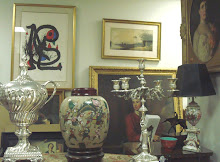 first Chicago artists to adopt Impressionism, bringing his colorful paintings back to the United States after a very influential twelve years in France at the height of the Impressionist movement. Buehr is known for his brilliantly colored landscape and figure paintings, particularly paintings of women surrounded by lush green backgrounds and an abundance of flowers. Buehr brought back to Chicago the beauty of Giverny, painting alongside contemporaries such as Monet and many other American expats.
first Chicago artists to adopt Impressionism, bringing his colorful paintings back to the United States after a very influential twelve years in France at the height of the Impressionist movement. Buehr is known for his brilliantly colored landscape and figure paintings, particularly paintings of women surrounded by lush green backgrounds and an abundance of flowers. Buehr brought back to Chicago the beauty of Giverny, painting alongside contemporaries such as Monet and many other American expats.Born in Germany
 in 1866, Buehr was one of seven children born to wealthy vineyard owners. Shortly after his birth, the Buehr family immigrated to Chicago in 1868. Karl wasted no time in pursuing a career in art and began working in the shipping department of a lithograph firm near the Art Institute of Chicago at the age of 14. Buehr began to visit the museum regularly and landed a part-time job, allowing him to enroll in night classes at the school. By 1888, Buehr was working at the Institute as a night watchman where he had a unique introduction to the masters by being able to observe and study them as he worked, most significantly Impressionist works.
in 1866, Buehr was one of seven children born to wealthy vineyard owners. Shortly after his birth, the Buehr family immigrated to Chicago in 1868. Karl wasted no time in pursuing a career in art and began working in the shipping department of a lithograph firm near the Art Institute of Chicago at the age of 14. Buehr began to visit the museum regularly and landed a part-time job, allowing him to enroll in night classes at the school. By 1888, Buehr was working at the Institute as a night watchman where he had a unique introduction to the masters by being able to observe and study them as he worked, most significantly Impressionist works.
Buehr completed his education at the Art Institute in 1897, graduating with honors and considered one of their most outstanding students. After school, Buehr briefly enlisted in the U.S. Army during the Spanish-American War, only to resume his studies in 1899 under artist Frank Duveneck. Buehr gained international recognition as a painting of his was exhibited at the Paris Salon of 1900. He stayed in Paris for two years to study at Académie Julian under Raphael Collin. After winning the bronze medal at the St. Louis Universal Exposition in 1904, Buehr and his family moved to France permanently the next year thanks to a generous patron. From there, Buehr traveled to Sicily and painted his surroundings for a year, moved to England to study at the London Art School for two years, and finally returned to Paris in 1908.
Shortly after moving back to France, Buehr began to paint at Giverny, the subject of many of Monet’s most famous works. In 1912, Buehr took up permanent residence in the village. While there, Buehr dev
 eloped friendships with fellow expats such as Richard Miller, Theodore Earl Butler, Lawton Parker, and formed an especially strong friendship with American Impressionist Frederick Frieseke. It is also claimed by Buerh’s son that his sister was a playmate of Monet’s granddaughter.
eloped friendships with fellow expats such as Richard Miller, Theodore Earl Butler, Lawton Parker, and formed an especially strong friendship with American Impressionist Frederick Frieseke. It is also claimed by Buerh’s son that his sister was a playmate of Monet’s granddaughter.
Giverny was the source of inspiration for Buehr’s notably colorful and lush backgrounds and landscapes, clearly reflecting his plein-air practices. Many of his paintings depict porch scenes with both groups of women and many with a single woman, though Buehr also did some interior paintings as well. His subjects were most often women sitting or standing around a table of some sort in thier feminine, floral dresses enjoying the colorful atmosphere surrounding them or soft skies above them. The women in Buerh’s works depicting a single woman were often painted with serious expressions, many times staring directly at the viewer. One of his most famous paintings, News From Home, was painted at Giverny and exhibited at the French Salon in 1913 and later at the Art Institute of Chicago. As the popularity of Impressionism declined, Buehr’s work essentially stayed within the Impressionist style but executed with wider brushstrokes. His subject matters and identifiably vibrant and expressive colors remained the same.
After a successful and influential nine years in Europe, Buehr returned to Chicago in 1914 and taught at the Art Institute until his death in 1952.
Sources:
http://www.askart.com/askart/artist.aspx?artist=25111
http://www.artnet.com/artists/karl+albert-buehr/biography-links
http://americangallery.wordpress.com/2010/03/08/karl-albert-buehr-1866-1952/
Researched and written by Alexandra Nilles.
MIR Appraisal Services, Inc.
Principal Appraiser: Farhad Radfar, ISA AM
307 N. Michigan Avenue, Suite 308
Chicago, IL 60601
(312) 814-8510
MIR Appraisal Services, Inc., is located just steps from the Art Institute of Chicago and the Chicago Cultural Center; please do give us a ring to set up an appointment for a verbal evaluation of your most prized works of art.










